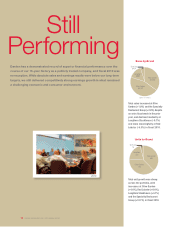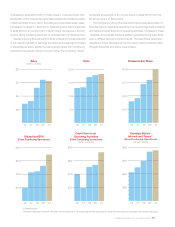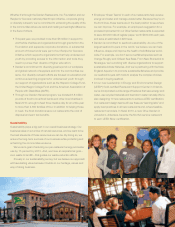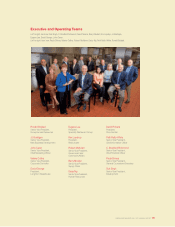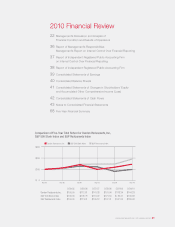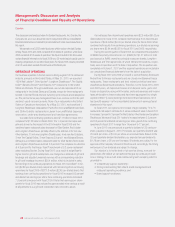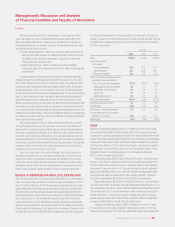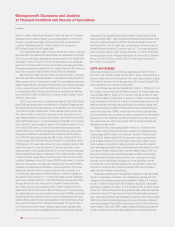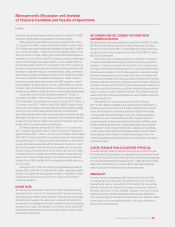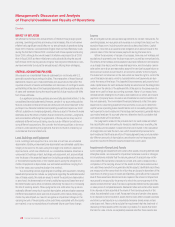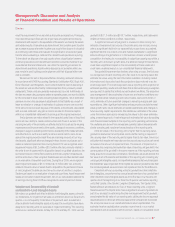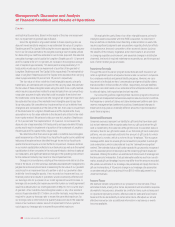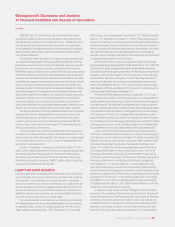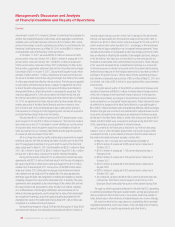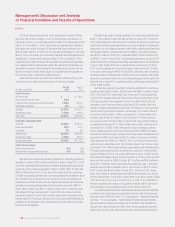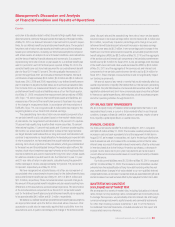Red Lobster 2010 Annual Report Download - page 25
Download and view the complete annual report
Please find page 25 of the 2010 Red Lobster annual report below. You can navigate through the pages in the report by either clicking on the pages listed below, or by using the keyword search tool below to find specific information within the annual report.
DARDEN RESTAURANTS, INC. | 2010 ANNUAL REPORT 23
Notes to Consolidated Financial Statements
Darden Restaurants
DARDEN RESTAURANTS, INC. | 2010 ANNUAL REPORT 23
Management’s Discussion and Analysis
of Financial Condition and Results of Operations
Darden
We seek to increase profits by leveraging our fixed and semi-fixed
costs with sales from new restaurants and increased guest traffic and
sales at existing restaurants. To evaluate our operations and assess our
financial performance, we monitor a number of operating measures, with
a special focus on two key factors:
•Same-restaurantsales–whichisayear-over-yearcomparisonof
each period’s sales volumes for restaurants open at least 16 months,
including recently acquired restaurants, regardless of when the
restaurantswereacquired;and
•Restaurantearnings–whichisrestaurant-levelprofitability
(restau rant sales, less restaurant-level cost of sales, marketing and
depreciation).
Increasing same-restaurant sales can improve restaurant earnings
because these incremental sales provide better leverage of our fixed and
semi-fixed restaurant-level costs. A restaurant brand can generate same-
restaurant sales increases through increases in guest traffic, increases in
the average guest check, or a combination of the two. The average guest
check can be impacted by menu price changes and by the mix of menu items
sold. For each restaurant brand, we gather daily sales data and regularly
analyze the guest traffic counts and the mix of menu items sold to aid in
developing menu pricing, product offerings and promotional strategies. We
view same-restaurant guest counts as a measure of the long-term health
of a restaurant brand, while increases in average check and menu mix may
contribute more significantly to near-term profitability. We focus on balancing
our pricing and product offerings with other initiatives to produce sustainable
same-restaurant sales growth.
We compute same-restaurant sales using restaurants open at least
16 months because this period is generally required for new restaurant
sales levels to normalize. Sales at newly opened restaurants generally do
not make a significant contribution to profitability in their initial months of
operation due to operating inefficiencies. Our sales and expenses can be
impacted significantly by the number and timing of new restaurant openings
and closings, relocation and remodeling of existing restaurants. Pre-opening
expenses each period reflect the costs associated with opening new
restaurants in current and future periods.
There are significant risks and challenges that could impact our
operations and ability to increase sales and earnings. The full-service
restaurant industry is intensely competitive and sensitive to economic
cycles and other business factors, including changes in consumer tastes
and dietary habits. Other risks and uncertainties are discussed and refer-
enced in the subsection below entitled “Forward-Looking Statements.”
RESULTS OF OPERATIONS FOR FISCAL 2010, 2009 AND 2008
The following table sets forth selected operating data as a percentage of
sales from continuing operations for the fiscal years ended May 30, 2010,
May 31, 2009 and May 25, 2008. This information is derived from the consoli-
dated statements of earnings found elsewhere in this report. Additionally,
this information and the following analysis have been presented with the
results of operations, gains and losses on disposition, impairment charges
and closing costs for the Smokey Bones and Rocky River Grillhouse
restaurants and the nine closed Bahama Breeze restaurants classified as
discontinued operations for all periods presented. The results of operations
of the LongHorn Steakhouse, The Capital Grille, Hemenway’s Seafood Grille
& Oyster Bar and The Old Grist Mill Tavern restaurants have been included
for all periods subsequent to their acquisition by Darden in the second
quarter of fiscal 2008. Hemenway’s Seafood Grille & Oyster Bar and The Old
Grist Mill Tavern restaurants were sold in the first and fourth fiscal quarters
of 2010, respectively.
Fiscal Years
2010 2009 2008
Sales 100.0% 100.0% 100.0%
Costs and expenses:
Cost of sales:
Food and beverage 28.8 30.5 30.1
Restaurant labor 33.1 32.0 32.1
Restaurant expenses 15.2 15.6 15.3
Total cost of sales, excluding restaurant
depreciation and amortization of
4.0%, 3.7% and 3.5%, respectively 77.1% 78.1% 77.5%
Selling, general and administrative 9.6 9.2 9.7
Depreciation and amortization 4.3 3.9 3.7
Interest, net 1.3 1.5 1.3
Asset impairment, net 0.1 0.2 0.0
Total costs and expenses 92.4% 92.9% 92.2%
Earnings before income taxes 7.6 7.1 7.8
Income taxes (1.9) (1.9) (2.2)
Earnings from continuing operations 5.7 5.2 5.6
(Losses) earnings from discontinued
operations, net of taxes (0.0) 0.0 0.1
Net earnings 5.7% 5.2% 5.7%
SALES
Sales from continuing operations were $7.11 billion in fiscal 2010, $7.22 bil-
lion in fiscal 2009 and $6.63 billion in fiscal 2008. The 1.4 percent decrease
in sales from continuing operations for fiscal 2010 was primarily driven by the
impact of the 53rd week in fiscal 2009 and the combined same-restaurant sales
decrease for Olive Garden, Red Lobster and LongHorn Steakhouse, partially
offset by the addition of 32 net new Olive Gardens, 10 net new LongHorn
Steakhouses, 4 net new Red Lobsters, 3 new The Capital Grilles, 3 new
Seasons 52s and 1 new Bahama Breeze. The 53rd week contributed
$123.7 million of sales in fiscal 2009.
Olive Garden sales of $3.32 billion in fiscal 2010 were 1.0 percent above
last year. Olive Garden opened 32 net new restaurants during fiscal 2010.
On a 52-week basis, annual U.S. same-restaurant sales for Olive Garden
decreased 1.0 percent due to a 3.0 percent decrease in same-restaurant
guest counts partially offset by a 2.0 percent increase in average guest check.
Average annual sales per restaurant for Olive Garden were $4.7 million in
fiscal 2010 compared to $4.8 million in fiscal 2009 (52-week basis).
Red Lobster sales of $2.49 billion in fiscal 2010 were 5.3 percent below
last year. Red Lobster opened four net new restaurants during fiscal 2010. On
a 52-week basis, annual U.S. same-restaurant sales for Red Lobster decreased
4.9 percent due to a 6.3 percent decrease in same-restaurant guest counts,
partially offset by a 1.4 percent increase in average guest check. Average
annual sales per restaurant for Red Lobster were $3.6 million in fiscal 2010
compared to $3.8 million in fiscal 2009 (52-week basis).
LongHorn Steakhouse sales of $881.8 million in fiscal 2010 were
0.7 percent below last year. LongHorn Steakhouse opened 10 net new
restaurants during fiscal 2010. On a 52-week basis, annual same-restaurant



